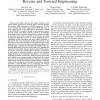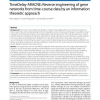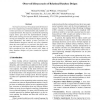70 search results - page 4 / 14 » Reverse engineering under siege |
BIOCOMP
2008
13 years 11 months ago
2008
Background: Inferring a gene regulatory network (GRN) from high throughput biological data is often an under-determined problem and is a challenging task due to the following reas...
INFOCOM
2006
IEEE
14 years 3 months ago
2006
IEEE
— This paper analyzes and designs medium access control (MAC) protocols for wireless ad-hoc networks through the network utility maximization (NUM) framework. We first reverse-e...
BMCBI
2010
13 years 10 months ago
2010
Background: One of main aims of Molecular Biology is the gain of knowledge about how molecular components interact each other and to understand gene function regulations. Using mi...
INFORMATICALT
2002
13 years 9 months ago
2002
In this paper, we present our Form-driven approach for reverse engineering of relationa databases. This methodology uses the information extracted from both form structure and inst...
WCRE
1995
IEEE
14 years 1 months ago
1995
IEEE
Several processes have been advanced in the literature for reverse engineering of relational databases. The inputs to these processes are relational tables and available contextua...



